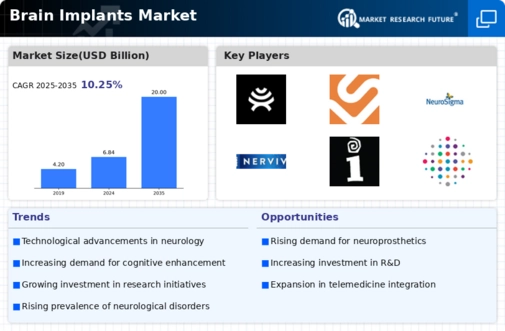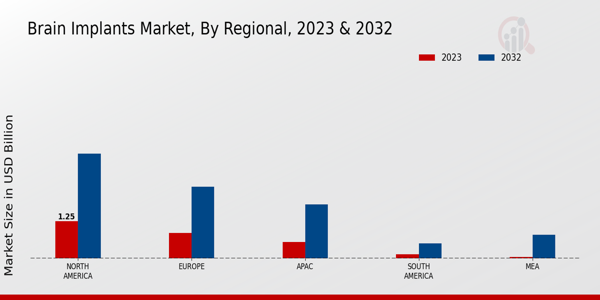Regulatory Support and Frameworks
The establishment of supportive regulatory frameworks is enhancing the growth prospects of the Brain Implants Market. Regulatory bodies are increasingly recognizing the potential of brain implants as viable medical solutions, leading to streamlined approval processes for new technologies. This regulatory evolution is crucial for fostering innovation, as it encourages companies to invest in research and development. Moreover, clear guidelines help ensure the safety and efficacy of brain implants, which is essential for gaining public trust. As regulatory environments become more conducive to innovation, the Brain Implants Market is likely to experience accelerated growth, with more products entering the market and improving patient outcomes.
Growing Investment in Neuroscience Research
Investment in neuroscience research is a crucial factor propelling the Brain Implants Market forward. Governments and private entities are allocating substantial funds to explore the complexities of the human brain and develop advanced therapeutic solutions. For instance, funding for brain research has seen a notable increase, with billions of dollars directed towards projects aimed at understanding brain function and developing innovative treatments. This influx of capital not only accelerates research but also fosters collaboration between academic institutions and industry players, leading to the rapid development of new brain implant technologies. As research continues to yield promising results, the Brain Implants Market is poised for expansion, with new products and applications emerging to meet the needs of patients and healthcare providers.
Technological Innovations in Brain Implants
The Brain Implants Market is experiencing a surge in technological innovations that enhance the functionality and safety of brain implants. Advancements in materials science, such as biocompatible materials, are enabling the development of implants that integrate more seamlessly with neural tissue. Furthermore, innovations in wireless communication technology allow for real-time data transmission, which is crucial for monitoring brain activity. According to recent estimates, the market for brain implants is projected to reach USD 5 billion by 2026, driven by these technological advancements. These innovations not only improve patient outcomes but also expand the range of applications for brain implants, including treatment for neurological disorders and cognitive enhancement. As technology continues to evolve, the Brain Implants Market is likely to witness further growth and diversification.
Increasing Prevalence of Neurological Disorders
The rising incidence of neurological disorders is a primary driver for the Brain Implants Market. Conditions such as Parkinson's disease, epilepsy, and traumatic brain injuries are becoming more prevalent, necessitating innovative treatment solutions. Recent data indicates that approximately 1 in 6 individuals will experience a neurological disorder in their lifetime, highlighting the urgent need for effective interventions. Brain implants offer promising solutions for managing these conditions, providing patients with improved quality of life and functional capabilities. As healthcare systems increasingly prioritize neurological health, the demand for brain implants is expected to rise significantly. This trend underscores the potential for growth within the Brain Implants Market, as stakeholders seek to address the challenges posed by these disorders.
Rising Awareness and Acceptance of Brain Implant Technologies
Public awareness and acceptance of brain implant technologies are on the rise, significantly impacting the Brain Implants Market. As educational initiatives and media coverage increase, more individuals are becoming informed about the benefits and potential of brain implants. This growing awareness is crucial for reducing stigma and fostering acceptance among patients and healthcare providers. Surveys indicate that a substantial portion of the population is open to considering brain implants as treatment options for various neurological conditions. This shift in perception is likely to drive demand, as more patients seek out innovative solutions for their health challenges. Consequently, the Brain Implants Market stands to benefit from this increasing acceptance, paving the way for broader adoption and utilization of brain implant technologies.


















Leave a Comment